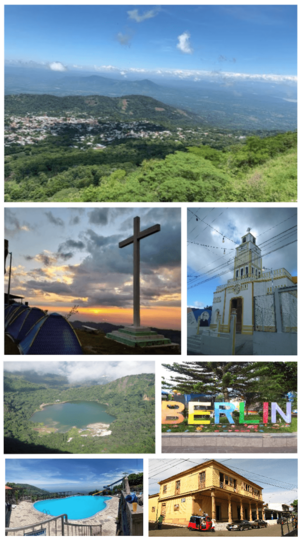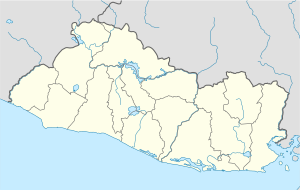Berlín, El Salvador facts for kids
Quick facts for kids
Berlin
|
||
|---|---|---|
|
Municipality
|
||

From left to right, top to bottom: Skyline of Berlín, Cerro La Cruz Viewpoint, Catholic Church of Berlín, Laguna de Alegría, Berlín Central Park, Berlín Pool Party, Historical Center of Berlín
|
||
|
||
| Motto(s):
Ciudad de Frescos Cafetales
"City of Fresh Coffee Plantations" |
||
| Country | ||
| Department | Usulután Department | |
| Founded | 1885 | |
| Named for | Berlin, Germany | |
| Area | ||
| • Total | 146.96 km2 (57 sq mi) | |
| Time zone | UTC6 (Central Standard Time) | |
| Area code(s) | +503 | |
| Website | berlinelsalvador.com/ | |
Berlin is a town in the Usulután Department of El Salvador. It is one of the main towns in the department. Berlin is located in eastern El Salvador, about 112 kilometers (70 miles) from the capital city, San Salvador. The town sits in the Tecapa-Chinameca-Alegría mountain area. This is in the central-north part of Usulután.
Berlin was founded in 1885. Before that, the area was known as "Gramalón" or "Agua Caliente." A German man named Serafin Brennen helped establish the town. He arrived after surviving a shipwreck off the coast of El Salvador.
Contents
Why is it Called Berlin?
The name Berlín comes from Serafín Brennen. He was the German citizen who survived a shipwreck. He traveled to the village of Agua Caliente. This village is now the town of Berlín. He made an agreement with the people living there. They decided to rename the village after Berlin, which is the capital of Germany. This is also why the town's flag looks very similar to the Flag of Germany.
A Look at History
Early Times
It is believed that the Lenca people lived here long ago. They settled in large numbers because there were many resources. Later, the Pipils arrived from the north. They entered what is now Berlin. This brought new cultural and language influences to the area.
Spanish Rule
From the 1500s, the area where Berlin would be was part of San Salvador. During this time, farming was important. Crops were grown for everyone, including the Ladinos. People became wealthy from crops in the 16th and 17th centuries. Indigo was a very profitable crop. It was more valuable than cocoa. However, growing indigo could also be harmful to the local people.
Becoming a Republic
In 1881, President Dr. Rafael Zaldívar made new laws. These laws changed how land was owned. Communal lands, once shared, became owned by a few people. This led to a big increase in coffee farming. Coffee soon replaced indigo as the main crop. The Agua Caliente valley was perfect for growing coffee. This is because it is on the side of the Alegría Volcano. Large farms were created to grow a lot of coffee. All of this helped Berlin become a key place for coffee production.
The Civil War Years
During the Salvadoran Civil War, Berlin was greatly affected. In early February 1983, there was intense fighting. Rebel groups entered the city. This made Berlin the most important city taken by rebels during the war.
On January 30, 1983, FMLN rebels entered Berlin. They took control after fighting government forces for several days. The rebels wanted to show their strength. However, they stayed for only five days. They then left the city.
After the rebels took the city, the Salvadoran military sent many soldiers. They came from other battle areas to regain control. This was a big moment in the civil war. It showed that battles were not just in the mountains. They were now happening in important cities too. Battles in a city like Berlin were big news. This was because Berlin was in a rich economic area. It caused concern for the Salvadoran government and the United States.
During that week, many people left Berlin. About half of the town's population evacuated. Several blocks in the city center were completely destroyed. There are still 13 places in Berlin with reminders of the fighting. Many people were affected and some lives were lost during these conflicts.
What Berlin Does for a Living
Berlin has relied on coffee since it was founded. Most of the land around the city has coffee farms. The high lands of Berlin are great for this crop. It grows well in high places. In the countryside around Berlin, people also grow corn and beans. They grow just enough for their families to eat. If they have extra, they sell it in Berlin's town area. Some people also raise chickens for food or to sell.
Coffee farming started in El Salvador a long time ago. It began around 1800 to 1815 in the Ahuachapán Department. From there, it spread across the country. By 1857, coffee farms appeared near Santa Ana, Ahuachapán, and Sonsonate.
Growing coffee helped Berlin's economy grow. Roads were improved to transport the coffee. Many people were needed to work. The coffee harvest season is from October to January. This time needs a lot of workers. Coffee farms also provide jobs at other times of the year. This is for maintaining the crops. This allowed most people in Berlin to make a living from coffee. Big farm owners, like the Meardi family, needed many workers. During harvest, whole families were hired. This helped families earn extra money.
Sometimes, there were not enough workers or income. This led to problems for towns that depended on coffee. Farms were abandoned, and people lost their jobs. This also meant less tax money for towns and departments.
Today, Berlin's economy also includes other businesses. About 11.70% are industrial companies. 76.42% are commercial companies (shops). 9.88% are service companies. And 2.00% are construction and transportation companies. However, farming is still the main way people make money in Berlin.
There is also an electricity company called La Geo. It creates electricity from heat inside the Earth (geothermal energy). This project started between 1976 and 1981. It helps provide jobs and economic growth for Berlin.
Berlin uses its coffee history to attract tourists. Its unique architecture also draws visitors. Many old houses have special metal walls imported from Belgium. These buildings were made between 1925 and 1930. They show Berlin's rich history.
Places to See
The most popular places in Berlin are the central park and the Catholic church of San José. The church was built in 1897 and updated in 1947. You can also see many old houses. Some parts of Berlin still show damage from the fighting in 1983 during the Salvadoran Civil War.
Images for kids
See also
 In Spanish: Berlín (El Salvador) para niños
In Spanish: Berlín (El Salvador) para niños





